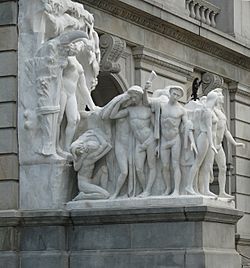Pennsylvania State Capitol sculpture groups facts for kids
Quick facts for kids Pennsylvania State Capitol sculpture groups |
|
|---|---|

Love and Labor: The Unbroken Law
|
|
| Artist | George Grey Barnard Piccirilli Brothers (carvers) |
| Year | commissioned 1902 dedicated October 4, 1911 |
| Medium | Carrara marble |
| Location | Harrisburg, Pennsylvania |
| Owner | Pennsylvania State Capitol |
The Pennsylvania State Capitol sculpture groups are two huge sets of statues. They stand on either side of the main entrance to the Pennsylvania State Capitol building in Harrisburg, Pennsylvania. A famous American sculptor named George Grey Barnard created them. He was asked to make these sculptures in 1902. Barnard spent several years in France making models of the statues from clay and plaster. Later, the Piccirilli Brothers carved the final sculptures from white Carrara marble in New York City. They were then put in place at the Capitol building.
There are two main groups of sculptures. The one on the south side is called The Burden of Life: The Broken Law. Above it, there is a large carving of Adam and Eve. This group shows difficult parts of life, like sadness, hard work, and feeling hopeless. But it also suggests that there can still be comfort and hope.
The group on the north side is called Love and Labor: The Unbroken Law. Above this group, there is a large carving of a successful farmer and his wife. This group shows good things in life, like family love, learning, being a parent, and faith. It also represents the hope for future generations.
Contents
How the Sculptures Were Made
Joseph Miller Huston, who designed the Capitol building, chose George Grey Barnard in 1902 to create outdoor sculptures. At first, they planned to have many more sculptures. They wanted eight groups of statues and a huge bronze artwork on the roof. This large artwork was meant to show the importance of work.
However, this plan was too expensive. So, they decided to make only the two large groups that stand at the main entrance. Barnard signed a contract in December 1902. His fee was $300,000. After this, Barnard and his family moved to France. There, they turned a large barn into a studio where he could create the sculptures.
Working in France
In his studio in Moret-sur-Loing, Barnard hired up to fifteen assistants. One of them was a plaster caster who helped turn Barnard's clay models into plaster figures.
Barnard had some financial problems while working on the sculptures. His assistants kept working for him, hoping they would be paid later. Barnard found a way to pay them by collecting old Gothic and Romanesque sculpture pieces from the French countryside and selling them. He also needed money to buy the marble for the final statues. A group of important people in New York helped him by providing funds for the marble.
Exhibitions Before Installation
Some of the large plaster sculptures for the Pennsylvania Capitol groups were shown to the public before they were finished.
1908 Boston Art Show
Five large plaster sculptures were part of an exhibition of Barnard's work. This show was at the Museum of Fine Arts, Boston in October and November 1908. These sculptures included The Prodigal Son, Brothers, The Young Parents, Kneeling Youth, and Forsaken Mother. Smaller models of the complete sculpture groups were also on display.
Art critics praised Barnard's work. One critic, J. Nilsen Laurvik, compared Barnard to famous sculptors like Auguste Rodin and Augustus Saint-Gaudens. He said Barnard's work was like "a breath of fresh sea air" and that he was one of the "truly great sculptors of our time." Another critic, William Howe Downes, also admired Barnard's ability to show the greatness and beauty of humanity in his art.
1910 Paris Art Show
The Piccirilli Brothers carved the sculptures in marble in New York City between 1909 and 1910. After they were finished, the marble sculptures were sent to France. They were shown for the first time to the public at the Paris Salon.
Barnard's sculpture groups were given a special place of honor at the 1910 Salon de Champ de Mars. This important art show was held at the Gran Palais in Paris.
Installation and Dedication
Giulio Piccirilli oversaw the installation of the sculptures at the Capitol. The statues were officially shown to the public on October 4, 1911.
The Prodigal Son Sculpture
One of the sculptures, The Prodigal Son, was also made into a marble version. Barnard showed this marble sculpture at the Armory Show in 1913. Today, this sculpture is part of the collection at the Carnegie Museum of Art in Pittsburgh, Pennsylvania. Another marble version of The Prodigal Son is at the Speed Art Museum in Louisville, Kentucky.
Images for kids



